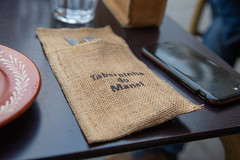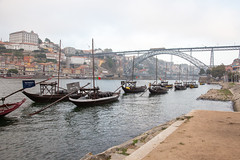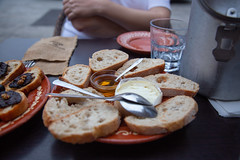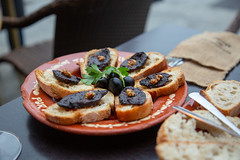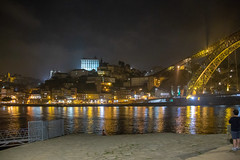Carol and I try to pick a different, quirky destination every year to continue our geographic and culinary exploration. Originally, we planned to do a trip to the Azores this year, but various scheduling and logistical issues kept that from happening during the ideal weather months. But the idea of visiting Portuguese islands got us thinking a bit, and when looking into alternative destinations, we realized that October was actually quite a good time to visit Porto and the Douro river valley. So, with the assistance of Portugal Green Walks, a touring service that arranges itineraries and manages luggage transfers between hotels, we booked a two-week stay in Portugal. If you are into “walking holidays”, I highly recommend them.
Arriving after a rather long day from a red-eye flight from Boston to Madrid, followed by a long layover and a short flight to Porto, we soon found ourselves settled into a hotel in Porto and setting out to do some modest exploration and dining before calling it and evening and leaving for Pinhão the next morning on the train. After a short walking tour checking out Lello (the famous bookstore), seeing the old city and Ribiera, and crossing over on the Dom Luís I Bridge, we spend our early evening relaxing and drinking port wine, and then decided that before we keeled over from hunger and exhaustion, we should probably get an early dinner and head back to the hotel.
For those that aren’t aware of it, the Iberian peninsula is renowned for their generally late hour of dining, so looking for a table around 7pm is more than a little early, but being a tourist town, we found Taberninha Do Manel (although one server joked we were obviously there for “lunch”). As we sat and enjoyed a particularly good view of the Vila Nova de Gaia waterfront and downtown Porto across the river, our server made a few wine recommendations and got us started on a selection of petiscos (small plates, much like the similar Spanish tapas) for the evening.
After starting with a rather pleasant vinho verde, we started off with some simple bread with soft cheese and olive oil. But the bread is a Portuguese speciality of the region: Broa de Avintes, which is a lighter rye farmhouse bread common to the region, and it made for a pleasant starter to the meal: a nice tangy rye with a good olive oil (Portugal has no shortage of great olive oil).
Next up: Morcela de porco preto assada, or blood sausage. When I was in Spain a few years ago, I really got to enjoy the various “morcilla” blood sausage, and this was really similar; basically, a really flavorful blood sausage that’s also got much of the same spicing as a good Portuguese chouriço or Andouille. Again, served up as nicely grilled slices over bits of bread, this was everything I enjoy about a great blood sausage.
Next was Pão recheado com 4 queijos, maionese, bacon, pickles e ervas aromáticas (bread with four cheeses, bacon, and herbs), and this basically did what it said on the tin: a larger loaf of hollowed out bread stuffed with a mix of cheese, bacon, and herbs, this was basically a hearty cheese dip, and we enjoyed every last little bit of it.
Then, unfortunately, there was a change in staff and our next order got lost and it took a rather long while to get that sorted out, but then our final dish arrives: Bochechas de vitela confitadas com molho de vinho tinto (Sorry, I may have messed up the Portuguese there, since they gave us both Spanish and English menus, but not Portuguese, but that’s veal cheeks braised in port wine). This reminded me about everything I love about cheek meat (cheeks for both veal and pork are basically “face bacon”), nicely stewed down to tender shreds in a slightly-but-not-overly-sweet port wine sauce. This was the star of the meal, with flavor just oozing out of the meat.
Part of me got a bit annoyed with the service, but realistically, this was more of a recalibration evening reminding us of some of the basics of Portuguese dining; we were unusually early for dinner, and thus had to handle a staffing transition. Also, it took us a few outings to get a bit more used to some of the Portuguese dining norms: while I could, and did, eventually get a check out of the staff to pay up, I later realized that unlike some other countries, simply going up to the register inside and saying I wanted to pay isn’t being pushy or rude by local standards; it’s actually normal behavior.
Overall, we had a particularly tasty, and not terribly expensive, pleasant meal on one of the early Fall’s best evenings, sitting and enjoying watching Porto turn from daylight, to pastel-colored mist, to nighttime lighting, while enjoying some excellent black sausage (some of the best of our trip), some good wine, and some good bread and cheese. I wouldn’t hesitate to revisit Taberninha Do Manel, although I’d probably wait until at least 8pm for another visit.
(And with this review, Offbeat Eats has now been to its 13th country!)

